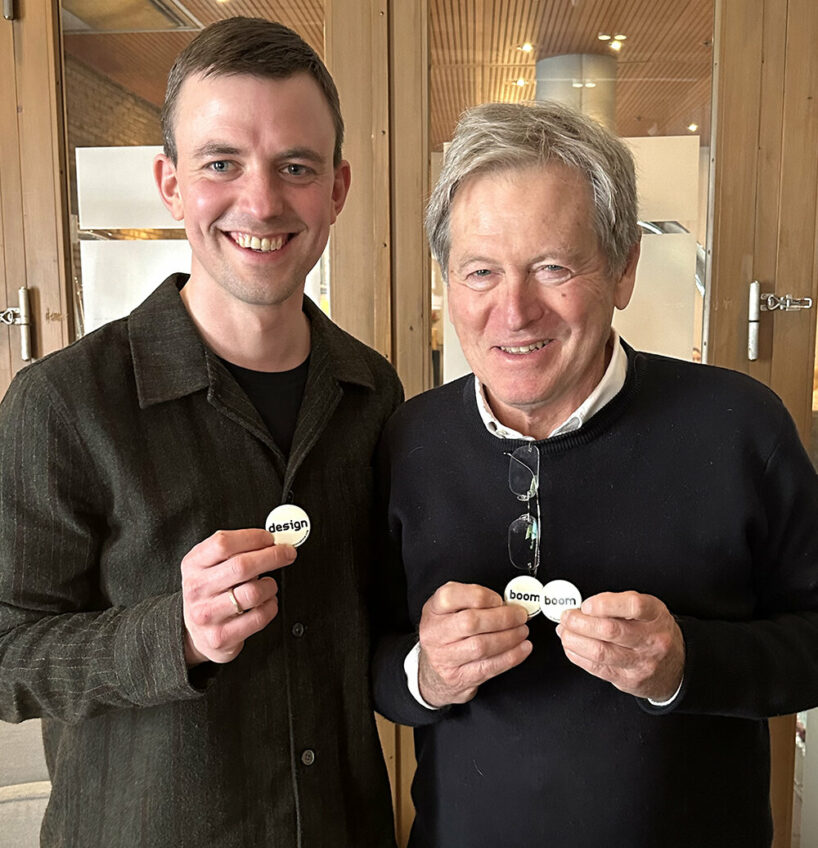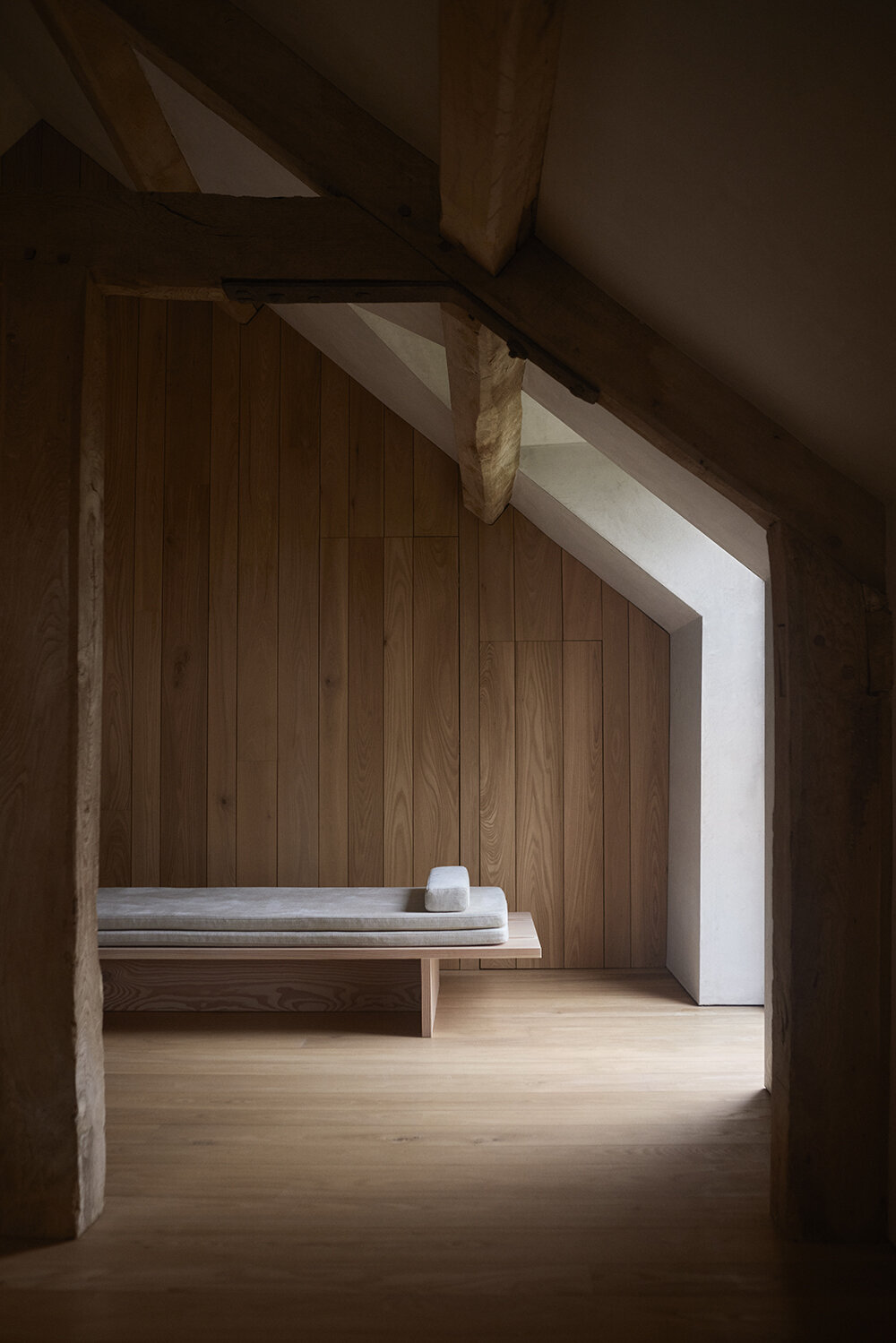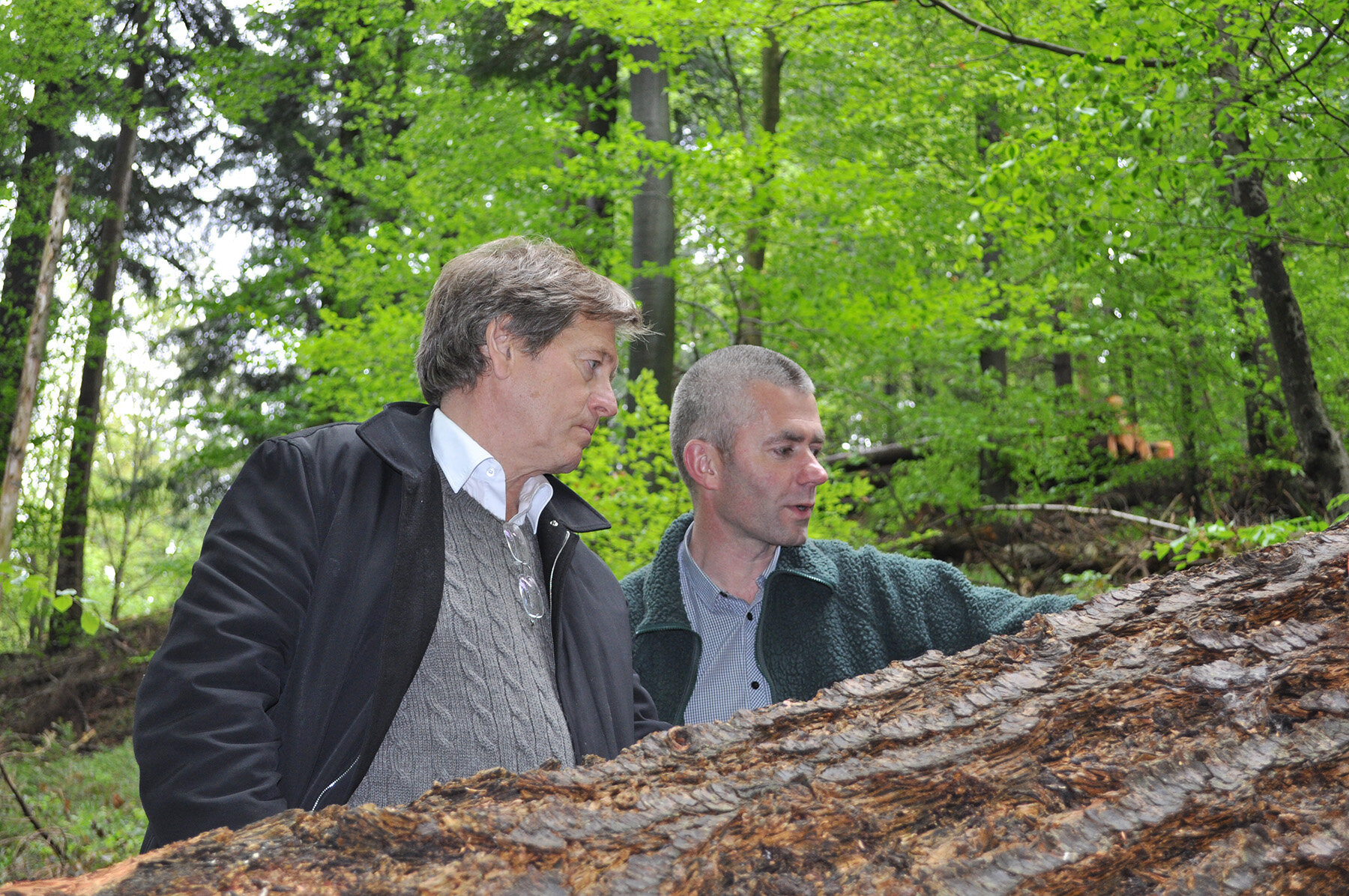introducing the pawson furniture collection
Dinesen, Denmark’s leading manufacturer of handcrafted wooden flooring and products, has announced a bespoke furniture collection with long-term collaborator and revered British architect John Pawson. The Pawson Furniture Collection is a new high point in a 30-year-long relationship, with fifth-generation Hans Peter Dinesen taking over the company today. As he tells designboom, the furniture series marks his ‘first direct collaboration with John and his office‘. According to the duo, the concept behind the design distills the ethos of the Danish word Umage, which means going beyond what is expected or considered possible, as it expands this sense of progression that Dinesen and Pawson bring to their work. The collection will be presented in 3daysofdesign in Copenhagen in June, in Dinesen’s showroom, which will be transformed into an apartment designed by the architect and furnished with the new pieces.

Pawson Furniture Collection | image © Claus Troelsgaard | @claustroelsgaard
inspired by the 1992 furniture series with DINESEN
The roots of the Pawson Furniture Collection for Dinesen can be traced back to the original furniture collection John Pawson created with Dinesen in 1992, solely for Pawson House, London. John discovered the company while designing his private home in Notting Hill and ordered Douglas Fir planks for the flooring. In two instantly defining gestures, the planks were laid uncut, in one piece, from the front of the house to the back, and boards of corresponding width were utilized to fabricate a table and stools. Pawson’s vision saw the floor become a crucial architectural element, giving the space a sense of direction. ‘The architecture depends on placing things well inside of it and having the right things to put in. You could negate a space by doing the wrong thing in the wrong place,‘ the architect shares with designboom.

image © Claus Troelsgaard
The bespoke furniture for Pawson House further championed Dinesen’s joinery in new and unexpected ways. The Pawson collection is based on the span of a Dinesen floorboard, whose pared-back forms consequently appear to be lifted directly out of the floor. It includes The Dining Series, which encompasses a dining table, bench, and stool, a design that John Pawson drew back in 1992. This design has been updated, adding a shadow gap detail. The top and legs of the dining table are fabricated from two boards. While the shadow gap between each pair of boards was left open in Pawson’s original design, this new iteration quietly expresses the gap using a different variety of timber — combining Douglas Fir planks with a slender insert of Dinesen Oak. ‘The furniture is very elemental. It’s sort of taken to the simplest form. It looks as if it’s all logical and pre-designed,’ John Pawson tells us. Stools and benches are made from a single Douglas Fir board with a solid central spine.

Hans Peter Dinesen (left) and John Pawson (right) | image © designboom
The Lounge Collection is a new complementary addition to the original Dining Series, made from Solid Douglas wood. It includes a lounge chair, lounge table, sofa, and daybed. Skilled local cabinet makers built the wooden frame in Denmark, upholstering it with textiles from the Danish company Kvadrat. The couch and armchair express the boards on the side elevation, while the cushions continue the theme of assembled and layered elements. The daybed and coffee table are conceived as lower versions of the dining table. As each piece of furniture is currently made to order, the end customer can choose the desired fabric from the Kvadrat upholstery library. ‘To find the right material is a long process that sets some kind of limitation in terms of scale. We just want to make sure that every piece is well made and will have as long a life as possible. We also have to see how the world responds to the furniture,’ Hans Peter clarifies.

Pawson Furniture Collection distills the ethos of the Danish word Umage | image © Claus Troelsgaard
a look at dinesen and pawson’s shared history
The 1992 commission was unlike anything Dinesen had previously delivered, and its success ignited a lifelong friendship and business partnership between fourth-generation Thomas Dinesen and John Pawson that has remained strong to this day. Since Thomas stepped down in 2021, his son Hans Peter has taken the reins to continue the family’s connection with Pawson for this new furniture launch. Beyond the 1992 commission and Pawson Furniture Collection, the three-decade-long collaboration between John Pawson and Dinesen includes projects of varying scale and type, including private homes, exhibitions, museums, retail, and chapels.

John Pawson (left) and Thomas Dinesen (right) | image courtesy Dinesen
Between 2017 and 2018, the architect constructed a wooden chapel in southern Germany using 61 Douglas Fir logs. Located on the outskirts of Unterliezheim, a Bavarian village, the structure is intended to be encountered as a found object — rather than a conventional work of architecture. Dinesen, who worked closely with six local forest owners, carefully sourced and collected the chapel’s logs. The Douglas Fir lends the interior a warm and tactile quality. At the same time, the chapel’s robust and raw external appearance will continue to evolve, and weather will change over time, becoming part of the forest it inhabits.

John Pawson’s chapel in southern Germany | image © felix friedmann | read more here
Another memorable project is Pawson’s 2016 remodeling of London’s Design Museum interiors. Inside the museum — which formed his first major public work — a series of calm, atmospheric spaces are articulated around an atrium comprising 2,700 square meters of Dinesen Oak planks that add to the architectural experience of the dramatic building. Sightlines are oriented towards the structure’s hyperbolic paraboloid roof, which spans the length of the building, rising on the two opposing corners to create an overhead manta ray-like structure. To ease circulation, galleries, learning spaces, the café, and the events space are arranged around the central atrium.

interiors of the Design Museum in London | image courtesy Dinesen | read more here
Moving on to retail, Pawson and Dinesen joined forces to complete the redesign of the Jil Sander flagship store in Paris. Set in a historically listed building amid the French capital, the architect has, in collaboration with Jil Sander creative directors Lucie and Luke Meier, created an elegant interior that feels grand and warm at the same time — with a beautiful chevron flooring and sculptural staircase in Dinesen Ash tying together the different rooms. The space features a rounded room, a gallery entrance, a welcoming space, a podium in the middle, and benches along the side walls. The hall becomes a stage for exhibitions and sources of inspiration.

Jil Sander flagship in Paris | image courtesy Dinesen
DINESEN’s five generations of sustainable forestry
Founded in 1898 by Hans Peter Dinesen, the manufacturing company carries four wood species in its product range (Douglas, Oak, Ash, and Pine) and five different solid flooring products (Dinesen Douglas, Dinesen Oak, Dinesen Heart Oak, Dinesen Ash, and Dinesen Pine). It also offers Dinesen Layers, an engineered flooring product made of solid wood. Through innovation and collaboration with architects and flooring installers worldwide, Dinesen creates sustainable designs that last for generations. Today, its renowned floor planks continue to be produced in Denmark’s small town of Jels, where it all began. First-generation Hans Peter, a master builder, could not find wood of the quality he wanted, so he started his own sawmill. Back then, the company was called Jels Savværk (Jels Sawmill) and had its production facility and shop in the town of Jels in South Jutland. Later, the company was renamed to include the family name, continuing as Dinesen Floors, and today simply as Dinesen.

Pawson Furniture Collection is based on the span of a Dinesen floorboard | image © Claus Troelsgaard
Dinesen’s basic philosophy has always been to utilize as much raw wood as possible out of respect for nature. This resource comes primarily from Schwarzwald (the Black Forest) in southern Germany and France, which has been family-owned for generations and sustainably managed for centuries. The forest and the soil have been cultivated by foresters who know every tree by heart. This creates a strong and resilient environment where the trees have the best growth conditions. This stance on sustainable foresting has always guided Dinesen’s vision. It constantly strives to preserve natural assets and maintain the ecological balance. In this way, the forest remains an asset with economic, social, and cultural benefits. An essential element of sustainable forestry is only to fell one tree at a time, allowing the trees to grow and develop their full potential before they are felled and ready to serve new purposes.

image © Claus Troelsgaard
During our conversation with Pawson and Dinesen, Hans Peter recalls how his grandfather adopted the idea of using one whole Douglas Fir tree to build a residence called the Winter House back in the 70s: ‘The tree was 170 years old, but it was old, and it died, so they call my grandfather to ask him if he could take care of this tree. He cut it up into planks, and it dried for six years, and then, without any drawings, they started to build a house. The walls were made of two planks, each one meter wide, and the floorboards were made of four pieces. Everything within the house — the furniture, the stools, plates, knife and fork, even the beds and the cradle — were made from the same tree. The joinery was also made with branches, like nails. It was like an experiment somehow.’ The grandfather was dedicated to using every part of the tree — going as far as tapping the water from the Douglas Fir and bottling it before selling it. The Winter House would hopefully stand its ground for a full 170 years, just like the Douglas Fir.

John Pawson (left) and Thomas Dinesen (right) | image courtesy Dinesen
In January 2021, after 122 years of owner management, the company appointed a professional CEO and a board of directors. The Dinesen family was happy to pass on responsibility for day-to-day business operations to a member outside the family who could fully exploit the brand’s potential in collaboration with the board of directors and the rest of the company management. The family now concentrates on the development of Dinesen in the future. Sustainability, product development, and strategic cooperation are now central tasks of the vision; Hans Peter even mentions how the company was working on finding ways to utilize sawdust, a challenge yet to be conquered. ‘Somehow, we want to continue this legacy and explore it in new ways. Constantly be curious about how to use one whole tree meaningfully. It’s a challenge because the world and our company are different today. There are more processes, and everything is more complex. It’s still really interesting, though, and we need architects and designers to succeed with this mission,’ he concludes.

image © Claus Troelsgaard

John Pawson | image © designboom

John Pawson (left) and Hans Peter Dinesen (right) at Home Farm, UK | image © Claus Troelsgaard





project info:
name: Pawson Furniture Collection for Dinesen | @dinesen
collaborators: Hans Peter Dinesen and John Pawson | @johnpawson
launching at: 3daysofdesign
dates: 12-14 june, 2024
3daysof (2)
john pawson (34)
wood and timber architecture and design (981)
PRODUCT LIBRARY
a diverse digital database that acts as a valuable guide in gaining insight and information about a product directly from the manufacturer, and serves as a rich reference point in developing a project or scheme.













